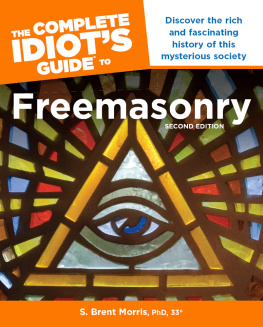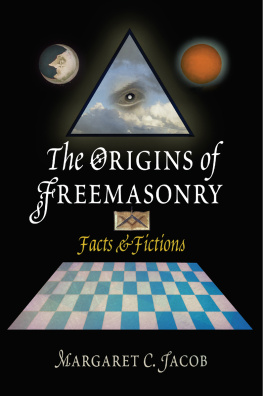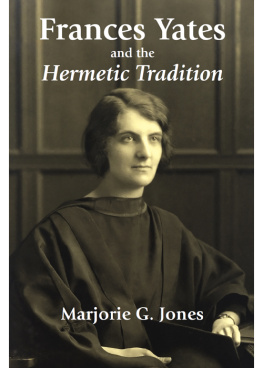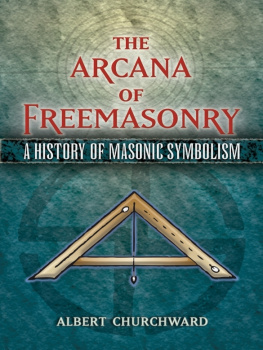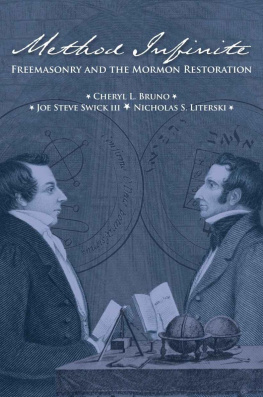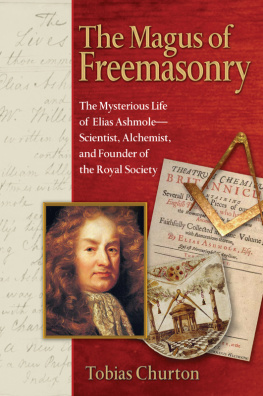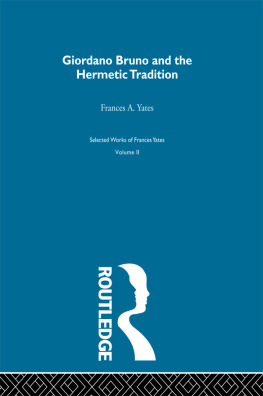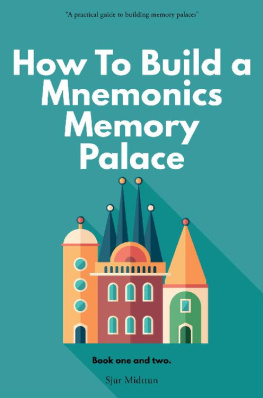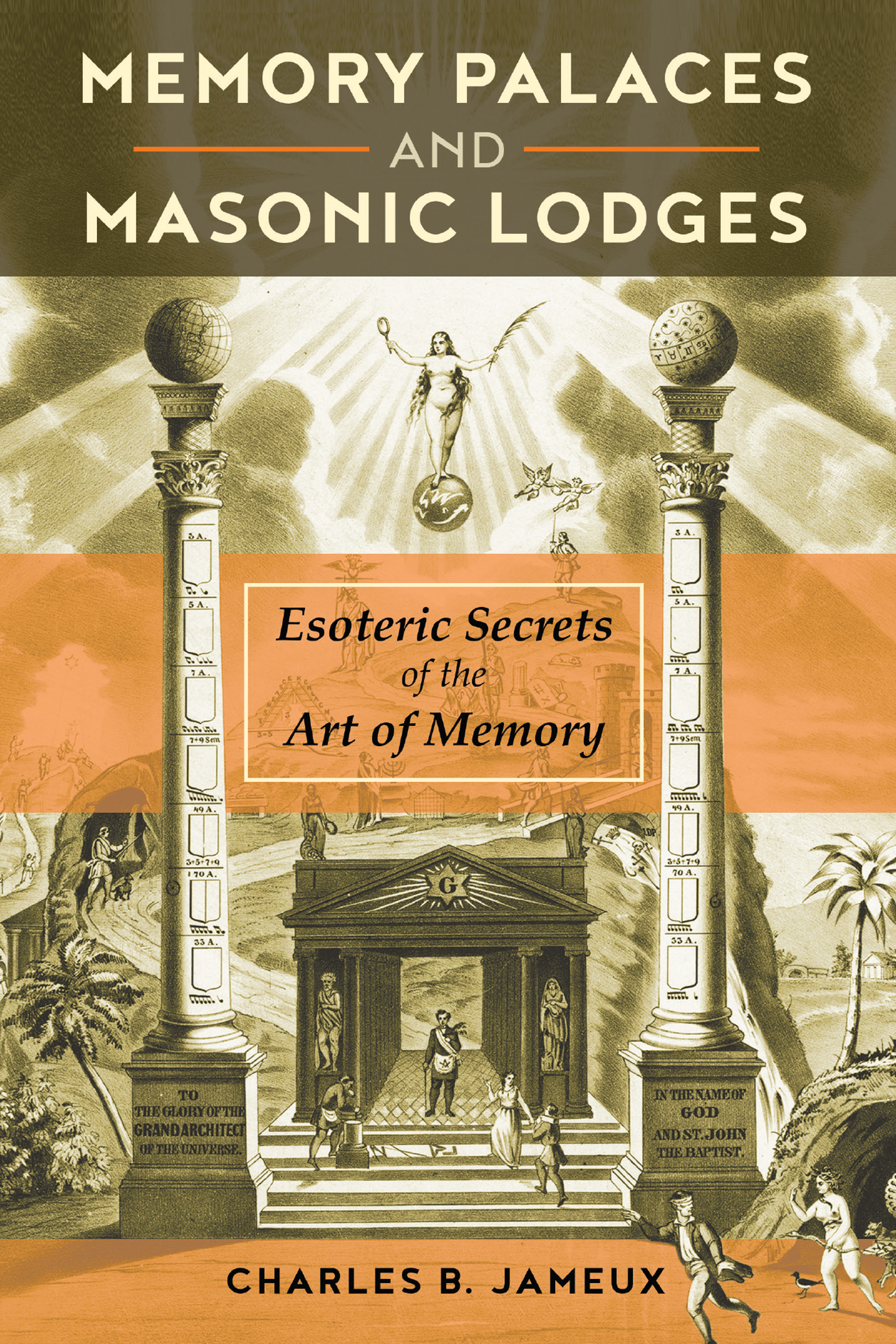To Claude Gagne
Memories are lies, and stories are fit only for children.
PAUL VALRY
Descartes required ten hours of sleep a night and lazed in bed until the sun was high in the sky. I regard this denigrated man as a visionary, of course, but it is not the Rosicrucian who will provide us with Method's final word. Between slumber and waking, the inner burden carries great weight and treats the sleeper's persona as a subordinate.
PHILIPPE AUDOIN
MEMORY PALACES
AND
MASONIC LODGES
"Memory Palaces and Masonic Lodges is a masterpiece of research on two topics: the art of memory and the lost Word of Freemasonry. Jameux's examination of Bruno's theories of the memory palace as a means to accessing celestial realms, coupled with how its application transforms Masonic trestle boards and temples into veritable talismans, is indispensable to understanding the history and practice of the transmission of knowledge in all its forms. This is a book I was planning on writing. Now I do not have to. Jameux has done the job for each of usnow all we need to do is apply it!"
MARK STAVISH, AUTHOR OF EGREGORES AND FREEMASONRY
FOREWORD
The Influences Leading to the Art
By Francis Bardot
ANYONE UNDERTAKING HISTORICAL RESEARCH on the transmission of ideas is faced with a constant temptation, one that will always lead to mistakes if one surrenders to it. This is the constant temptation to give factual historical accuracy the upper hand over the subtle reality of the murmur of influences.
Or to restate this in the words of Antoine de Saint-Exupry, "To be tempted is to be tempted, when the spirit is asleep, to surrender to the reasons of the mind."
There are countless examples of this. It starts with the legacy of the Greeks. In our desire to make them the ancestors of our rationalist thought, we easily gather together evidence of this aspect of their thought: the Stoics crafting language and grammar, the influences of Aristotle's philosophy all the way up to the time of medieval Scholasticismthere is no shortage of examples.
This overlooks the fact that Greek thought unfailingly maintained a permanent overlapping of mythos and logos, as shown by the sole true crucible of Greek civilizationtragedy. We are clearly the heirs of the Romans, and the mishap was created when Cicero could find no better term in the Latin language to translate the concept of logos than the impoverished term of ratio.
In the same order of things, it is probably easy, because it has been factually recognized, to prove that the Ancient and Accepted Scottish Rite was born among the Masons that frequented the modern lodges. But who could deny that the reformist impulse for a return to a true speculative Masonrythat of seventeenth-century Scotlandis clearly the one that inspired the secession of the Antients and to some extent anticipated the Compromise of 1813, which engendered the Rite of Perfection?
Who, outside of Lubac and his readers, could recover the trail of the Calabrian monk Joachim of Fiori in the works of Voltaire and Hegel? Who, unless they followed Cicero to Rhodes, would have been able to rediscover the origins of the Stoic ideas Saint Augustine instilled into Christianity? What, other than reading, could confirm that Meister Eckhart's notion of God's birth in the soul came directly from Proclus?
Charles B. Jameux is one of those spirits whose historical quest in the Masonic domainrigorous in its hunt for factsis no less guided by a very sure initiatory habitus.
The study he made in the mid-nineties on the connection between the art of memory of antiquity and Masonic methodology shed a new, and surprisingly powerful, light on our considerations of the Royal Art (included in this U.S. edition as appendix B). The important work he had performed based on that of Frances Yates and David Stevenson inspired a wealth of new studies and publications, when they were not simply pillaged without due credit from the sources he made available.
The latest results of his research will be, in my opinion, just as fruitful for the Masonic reflection and understanding of those not satisfied with simply attending lodge meetings. It is based on two pillars: one is a study concerning the appearance of the Mason Word and its meaning within its proper spatiotemporal environment. The other draws its Masonic conclusions from an enlightening text by Claudie Balavoine, who is in charge of art history studies at the CNRS (Centre National de la Recherche Scientifique).
This final contribution retraces the emergence of a hieroglyphic script in the arts of memory during the sixteenth and seventeenth centuries, but its value to us consists especially in the description it provides of the inescapable seizure, by the letter, of the domain of the image. Like the soul of Plato falling into the body, the symbol was buried within the word. Here is where the mystery went astray!
The purpose of a preface is not to deflower the enthralling nature of an investigation, no more than it is to offer contemplation of it to someone unwilling to follow the path that leads to it.
Nevertheless...
We remain Masons because we refuse a world that is purely rational. So where would we find the inheritors of these images, that an art of memory nourished by Neoplatonism from antiquity made available to the Renaissance as a viaticum for a quest for meaning beyond forms and appearances? Where would we find those heirs who are first the guardians and then the transmitters in turn to those they deem worthy of them? Was it not our founders' plan to hide them by giving them the means to live clandestinely as symbols, in order to reserve their discovery to initiates?
In beginning this brief text, I spoke of the pneumatic line of descent of ideas. While the cathedral builders likely prefigured what we are, it was nevertheless in Renaissance Neoplatonism that the poetic and sacred cosmogony that forms the milieu in which our initiatory spirit moves were anchored.
In the debates of the Western evolution of thought, it is customary to show how scholastic thinkers, followed by the disciples of William of Ockham, who preferred Aristotle to Plato, decisively separated the world above from that of manifestation, which ensured it was no longer seen as one indivisible whole.
But it was Plato's victory over Neoplatonism, and Galileo's victory establishing the primacy of mathematics over experience for understanding reality, which was the true origin of Western science going astray.
Charles B. Jameux's intuition allows us to perceive from this perspective a very enlightening and plausible hypothesis on the origins of the symbols of contemporary speculative Freemasonry. I wager that they will form, like his first study on the art of memory, a departure point for many works to come. This foreword is intended to help prevent those who create these future works from forgetting to give credit where it is due.
FRANCIS BARDOT is the president of the French National Choral Directors Association and a member of the Grand Lodge of the Alliance Maonnique Franaise. A knight of the French Legion of Honor, he is also a 33rd-degree Mason of the Ancient and Accepted Scottish Rite.
Foreword
The Art of Memory



